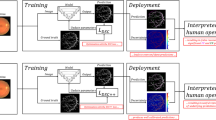Abstract
Segmentation is a fundamental task in medical image analysis. The clinical interest is often to measure the volume of a structure. To evaluate and compare segmentation methods, the similarity between a segmentation and a predefined ground truth is measured using metrics such as the Dice score. Recent segmentation methods based on convolutional neural networks use a differentiable surrogate of the Dice score, such as soft Dice, explicitly as the loss function during the learning phase. Even though this approach leads to improved Dice scores, we find that, both theoretically and empirically on four medical tasks, it can introduce a volumetric bias for tasks with high inherent uncertainty. As such, this may limit the method’s clinical applicability.
J. Bertels and D. Robben—Contributed equally to this work.
Access this chapter
Tax calculation will be finalised at checkout
Purchases are for personal use only
Similar content being viewed by others
References
NEXIS - Next gEneration X-ray Imaging System. https://www.nexis-project.eu
Ischemic Stroke Lesion Segmentation (ISLES) challenge (2017). http://www.isles-challenge.org/ISLES2017/
Ischemic Stroke Lesion Segmentation (ISLES) challenge (2018). http://www.isles-challenge.org/ISLES2017/
Multimodal Brain Tumor Segmentation (BRATS) challenge (2018). https://www.med.upenn.edu/sbia/brats2018.html
Bakas, S., et al.: Advancing The Cancer Genome Atlas glioma MRI collections with expert segmentation labels and radiomic features. Sci. Data 4(March), 1–13 (2017). https://doi.org/10.1038/sdata.2017.117
Bakas, S., et al.: Identifying the Best Machine Learning Algorithms for Brain Tumor Segmentation, Progression Assessment, and Overall Survival Prediction in the BRATS Challenge (2018). http://arxiv.org/abs/1811.02629
Bertels, J., et al.: Optimizing the Dice score and Jaccard index for medical image segmentation: theory and practice. In: Medical Image Computing and Computer-Assisted Intervention (2019)
De Tobel, J., Radesh, P., Vandermeulen, D., Thevissen, P.W.: An automated technique to stage lower third molar development on panoramic radiographs for age estimation: a pilot study. J. Forensic Odonto-Stomatol. 35(2), 49–60 (2017)
Drozdzal, M., Vorontsov, E., Chartrand, G., Kadoury, S., Pal, C.: Deep Learning and Data Labeling for Medical Applications. LNCS, vol. 10008, pp. 179–187. Springer, Heidelberg (2016). https://doi.org/10.1007/978-3-319-46976-8
Goodfellow, I., Bengio, Y., Courville, A.: Deep Learning. MIT Press, Cambridge (2016)
Goyal, M., et al.: Endovascular thrombectomy after large-vessel ischaemic stroke: a meta-analysis of individual patient data from five randomised trials. Lancet 387(10029), 1723–1731 (2016). https://doi.org/10.1016/S0140-6736(16)00163-X
Isensee, F., Kickingereder, P., Wick, W., Bendszus, M., Maier-Hein, K.H.: No new-net. In: Crimi, A., Bakas, S., Kuijf, H., Keyvan, F., Reyes, M., van Walsum, T. (eds.) BrainLes 2018. LNCS, vol. 11384, pp. 234–244. Springer, Cham (2019). https://doi.org/10.1007/978-3-030-11726-9_21
Kamnitsas, K., Ledig, C., Newcombe, V.F.J.: Efficient multi-scale 3D CNN with fully connected CRF for accurate brain lesion segmentation. Med. Image Anal. 36, 61–78 (2017)
Menze, B.H., et al.: The multimodal Brain Tumor Image Segmentation Benchmark (BRATS). IEEE Trans. Med. Imaging (2015). https://doi.org/10.1109/TMI.2014.2377694
Milletari, F., Navab, N., Ahmadi, S.A.: V-Net: fully convolutional neural networks for volumetric medical image segmentation. In: International Conference on 3D Vision, vol. 4, pp. 1–11 (2016). https://doi.org/10.1109/3DV.2016.79, http://arxiv.org/abs/1606.04797
Sudre, C.H., Li, W., Vercauteren, T., Ourselin, S., Jorge Cardoso, M.: Generalised dice overlap as a deep learning loss function for highly unbalanced segmentations. In: Cardoso, M.J., et al. (eds.) DLMIA/ML-CDS -2017. LNCS, vol. 10553, pp. 240–248. Springer, Cham (2017). https://doi.org/10.1007/978-3-319-67558-9_28
Vapnik, V.N.: The Nature of Statistical Learning Theory. Springer, Heidelberg (1995). https://doi.org/10.1007/978-1-4757-3264-1
Winzeck, S., et al.: ISLES 2016 and 2017-benchmarking ischemic stroke lesion outcome prediction based on multispectral MRI. Front. Neurol. 9(SEP) (2018). https://doi.org/10.3389/fneur.2018.00679
Acknowledgements
J.B. is part of NEXIS [1], a project that has received funding from the European Union’s Horizon 2020 Research and Innovations Programme (Grant Agreement #780026). D.R. is supported by an innovation mandate of Flanders Innovation and Entrepreneurship (VLAIO).
Author information
Authors and Affiliations
Corresponding author
Editor information
Editors and Affiliations
Rights and permissions
Copyright information
© 2020 Springer Nature Switzerland AG
About this paper
Cite this paper
Bertels, J., Robben, D., Vandermeulen, D., Suetens, P. (2020). Optimization with Soft Dice Can Lead to a Volumetric Bias. In: Crimi, A., Bakas, S. (eds) Brainlesion: Glioma, Multiple Sclerosis, Stroke and Traumatic Brain Injuries. BrainLes 2019. Lecture Notes in Computer Science(), vol 11992. Springer, Cham. https://doi.org/10.1007/978-3-030-46640-4_9
Download citation
DOI: https://doi.org/10.1007/978-3-030-46640-4_9
Published:
Publisher Name: Springer, Cham
Print ISBN: 978-3-030-46639-8
Online ISBN: 978-3-030-46640-4
eBook Packages: Computer ScienceComputer Science (R0)





